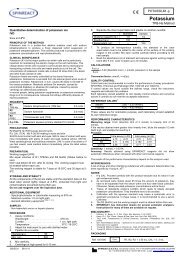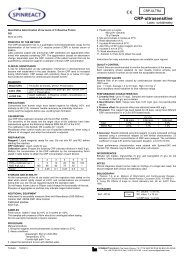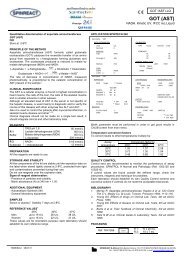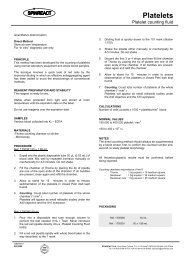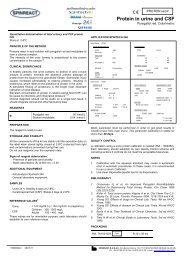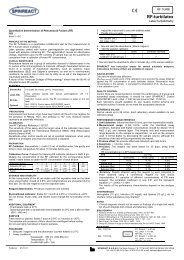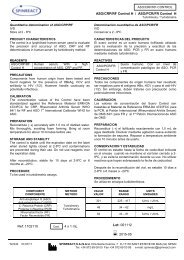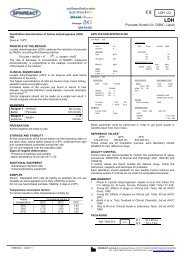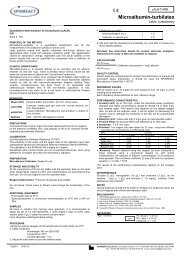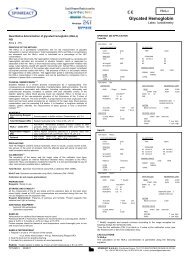RF-turbilatex
Tecnicas Ingles-Español Turbilatex - Spinreact
Tecnicas Ingles-Español Turbilatex - Spinreact
- No tags were found...
Create successful ePaper yourself
Turn your PDF publications into a flip-book with our unique Google optimized e-Paper software.
<strong>RF</strong>-TURBI<br />
<strong>RF</strong>-<strong>turbilatex</strong><br />
Latex turbidimetry<br />
Quantitative determination of Rheumatoid Factors (<strong>RF</strong>)<br />
IVD<br />
Store at 2- 8ºC.<br />
PRINCIPLE OF THE METHOD<br />
The <strong>RF</strong>-Turbilatex is a quantitative turbidimetric assay for the measurement of<br />
Rheumatoid Factors (<strong>RF</strong>) in human serum or plasma.<br />
Latex particles coated with human gammaglobulin are agglutinated when<br />
mixed with samples containing <strong>RF</strong>. The agglutination causes an absorbance<br />
change, dependent upon the <strong>RF</strong> contents of sample that can be quantified by<br />
comparison against a calibrator of known <strong>RF</strong> concentration.<br />
CLINICAL SIGNIFICANCE<br />
Rheumatoid factors are a group of auto-antibodies directed to the Fc portion of<br />
IgG. Although rheumatoid factors are found in a number of rheumatoid<br />
disorders, such as systemic lupus erythematosus (SLE) and Sjögren’s<br />
syndrome, as well as in nonrheumatic conditions, it is most commonly used in<br />
the diagnosis of rheumatoid arthritis (RA). About 80% of RA patients are <strong>RF</strong><br />
positive.<br />
REAGENTS<br />
Diluent (R1)<br />
Latex (R2)<br />
<strong>RF</strong>-CAL<br />
Tris buffer 20 mmol/L, pH 8.2. Preservative.<br />
Latex particles coated with human gammaglobulin, pH 7.4.<br />
Preservative.<br />
Calibrator. Human serum. The <strong>RF</strong> concentration is stated on<br />
the vial label.<br />
PRECAUTIONS<br />
Components from human origin have been tested negative for HBsAg, HCV,<br />
and antibody to HIV (1/2). However handle cautiously as potentially infectious.<br />
Gently swirl the reagents before use, avoiding foam formation.<br />
CALIBRATION<br />
Use <strong>RF</strong> Calibrator included with the kit (Ref.1107007).<br />
The sensitivity of the assay and the target value of the calibrator have been<br />
standardized against the Rheumatoid Arthritis International Reference Material<br />
NIBSC 64/002.<br />
The calibration in the Spintech240 is stable for 4 weeks.<br />
Recalibrate when control results are out of specified tolerances, when using<br />
different lot of reagent and when the instrument is adjusted.<br />
PREPARATION<br />
Reagent: Liquid reagents ready to use. Do not mix R1 and R2 before starting<br />
the reaction.<br />
<strong>RF</strong> Calibrator: Reconstitute ( ) with 2.0 mL of distilled water. Mix gently and<br />
bring to room temperature for about 10 minutes before use.<br />
Calibration Curve: Prepare the following <strong>RF</strong> calibrator dilutions in NaCl 9 g/L.<br />
Multiply the concentration of the <strong>RF</strong> calibrator by the corresponding factor<br />
stated in table bellow to obtain the <strong>RF</strong> concentration of each dilution:<br />
Dilución calibrador 1 2 3 4 5 6<br />
Calibrador FR (µL) -- 25 50 100 200 400<br />
NaCl 9 g/L (µL) 400 375 350 300 200 -<br />
Factor 0 0,0625 0,125 0,25 0,5 1,0<br />
STORAGE AND STABILITY<br />
All the components of the kit are stable until the expiration date stated on the<br />
label when stored tightly closed at 2-8ºC and contaminations are prevented<br />
during their use. Do not use reagents over the expiration date.<br />
Reconstituted <strong>RF</strong> calibrator: Stable for 1 month at 2-8ºC or 3 months at –20ºC.<br />
Do not freeze; frozen latex and diluent could change the functionality of the<br />
test.<br />
Presence of aggregates or particles may indicate reagent deterioration.<br />
ADDITIONAL EQUIPMENT<br />
Instrument to accurately measure time and Absorbance at 660nm.<br />
Controls: Ref.:1102114 Control serum ASO/CRP/<strong>RF</strong> (Level L); Ref.:1102115<br />
Control serum ASO/CRP/<strong>RF</strong> (Level H).<br />
Calibrated pipettes.<br />
NaCl 9 g/L.<br />
SAMPLES<br />
Fresh serum or plasma. Stable 7 days at 2-8ºC or 3 months at –20ºC.<br />
The samples with presence of fibrin should be centrifuged before testing.<br />
Do not use highly hemolized or lipemic samples.<br />
Wavelength: 660 nm<br />
Temperature: 37ºC<br />
Cuvette light path: 1 cm<br />
3. Adjust the instrument to zero with distilled water.<br />
4. Pipette into a cuvette:<br />
800 µl R1 (Diluent)<br />
10 µl Sample<br />
5. Mix and incubate 4 minutes at 37ºC.<br />
6. Read absorbance (A1).<br />
7. Incubate 45 seconds at 37ºC.<br />
8. Add 180 µl of R2 (Latex reagent) and mix.<br />
9. Incubate 5 min at 37ºC<br />
10. Read absorbance (A2).<br />
11. Subtract A1 from A2 to obtain the result.<br />
Instructions for many automatic analyzers are available upon request.<br />
QUALITY CONTROL<br />
Control Sera are recommended to monitor the performance of the assay.<br />
Each laboratory should establish its own Quality Control scheme and<br />
corrective actions if controls do not meet the acceptable tolerances.<br />
REFERENCE VALUES<br />
Normal values up to 20 IU/mL. Each laboratory should establish its own<br />
reference range.<br />
PE<strong>RF</strong>ORMANCE CHARACTERISTICS<br />
1. Linearity limit: Up to 140 IU/mL. Samples with higher concentrations<br />
should be diluted in NaCl 9 g/L and re-tested.<br />
2. Quantification limit: Values less than 6 IU/mL give non-reproducible<br />
results.<br />
3. Prozone effect: No prozone effect was detected below 800 IU/mL.<br />
4. Precision: The reagent has been tested for 20 days, using three<br />
different FR concentrations in a CLSI-EP5-based study.<br />
CV (%)<br />
36 IU/mL 78 IU/mL 123 IU/mL<br />
Total 4.5% 4.1% 5.9%<br />
Within Run 3.3% 2.6% 3.2%<br />
Between Run 1.7% 2.3% 3.4%<br />
Between Day 2.5% 2.1% 3.6%<br />
5. Accuracy: Results obtained using this reagent (y) were compared to<br />
those obtained using a commercial reagent (x) with similar<br />
characteristics. 41 samples of different concentrations of FR were<br />
assayed. The correlation coefficient (r) was 0.91 and the regression<br />
equation y = 1.2042x +3.1344.<br />
These performance characteristics were studied with Spintech240 and<br />
Spinlab180. Characteristics may be different with other instruments.<br />
INTE<strong>RF</strong>ERENCES<br />
Hemoglobin (10 g/L), bilirrubin (20 mg/dL) and lipids (5 g/L), do not<br />
interfere. Other substances may interfere 6 .<br />
NOTES<br />
Clinical diagnosis should not be made on findings of a single test result, but<br />
should integrate both clinical and laboratory data.<br />
BIBLIOGRAPHY<br />
1. Frederick Wolfe et al. Arthritis and Rheumatism 1991; 34: 951- 960.<br />
2. Robert W Dorner et al. Clinica Chimica Acta 1987; 167: 1-21.<br />
3. Robert H Shmerling et al. The American J. of Medicine 1991; 91: 528 – 534.<br />
4. Vladimir Muié et al. Scand J Rheumatology 1972; 1: 181 – 187.<br />
5. Paul R et al. Clin Chem 1979; 25/11: 1909 – 1914.<br />
6. Young DS. Effects of drugs on clinical laboratory test, 4th ed. AACC Press,<br />
1995.<br />
7. Barra L et al., Rheumatology-Oxford, 2011; 50:311-6.<br />
PACKAGING<br />
Ref.: 1107105<br />
Ref.: 1107105L<br />
Cont.<br />
R1. Diluent: 1 x 40 mL<br />
R2. Latex :1 x 10 mL<br />
<strong>RF</strong>-CAL:1 x 2 mL<br />
R1. Diluent: 1 x 200 mL<br />
R2. Latex :1 x 50 mL<br />
<strong>RF</strong>-CAL:1 x 2 mL<br />
PROCEDURE<br />
Manual procedure:<br />
1. Bring the reagents and the photometer (cuvette holder) to 37ºC.<br />
2. Assay conditions:<br />
TLIS41-I 19/03/13 SPINREACT,S.A./S.A.U.Ctra.Santa Coloma, 7 E-17176 SANT ESTEVE DE BAS (GI) SPAIN<br />
Tel. +34 972 69 08 00 Fax +34 972 69 00 99 e-mail: spinreact@spinreact.com
<strong>RF</strong>-TURBI<br />
FR-turbilátex<br />
Turbidimetría Látex<br />
Determinación cuantitativa de Factores Reumatoides (FR)<br />
IVD<br />
Conservar a 2- 8ºC.<br />
PRINCIPIO DEL MÉTODO<br />
El FR-Turbilátex es un ensayo turbidimétrico para la cuantificación de factores<br />
reumatoides (FR) en suero o plasma humano.<br />
Las partículas de látex recubiertas con gammaglobulina humana son<br />
aglutinadas por FR presentes en la muestra del paciente. El proceso de<br />
aglutinación provoca un cambio de absorbancia proporcional a la<br />
concentración de FR de la muestra, y por comparación con un calibrador de<br />
FR de concentración conocida se puede determinar el contenido de FR en la<br />
muestra ensayada.<br />
SIGNIFICADO CLÍNICO<br />
Los factores reumatoides son un grupo de auto-anticuerpos dirigidos contra la<br />
fracción Fc de las inmunoglobulinas IgG. Aunque se hallan presentes en un<br />
gran número de desordenes reumáticos, tales como el lupus eritematoso<br />
sistémico (SLE) y el síndrome de Sjögren, su principal interés clínico radica en<br />
el diagnóstico de la artritis reumatoide. Aproximadamente el 80% de pacientes<br />
con artritis reumatoide son positivos para FR.<br />
REACTIVOS<br />
Diluyente (R1)<br />
Látex (R2)<br />
<strong>RF</strong>-CAL<br />
Tampón tris 20 mmol/L, pH, 8,2 . Conservante.<br />
Partículas de látex recubiertas de gammaglobulina<br />
humana, pH, 7,4. Conservante.<br />
Calibrador. Suero humano. La concentración de FR<br />
viene indicada en la etiqueta del vial.<br />
PRECAUCIONES<br />
Todos los componentes de origen humano han resultado ser negativos para el<br />
antígeno HBsAg, HCV, y para el anti-HIV (1/2). Sin embargo, deben tratarse<br />
con precaución como potencialmente infecciosos.<br />
Homogeneizar los reactivos con suavidad por inversión antes de utilizar,<br />
evitando la formación de espuma.<br />
CALIBRACIÓN<br />
Usar el Calibrador FR incluido en el kit (Ref. 1107007).<br />
La sensibilidad del ensayo y el valor de concentración del calibrador están<br />
estandarizados frente el Patrón Internacional de Artirtis Reumatoide del<br />
NIBSC 64/002.<br />
Recalibrar cuando los resultados del control estén fuera de especificaciones,<br />
cuando se utilice diferente lote de reactivo y cuando se ajuste el instrumento.<br />
PREPARACIÓN<br />
Reactivo: Reactivo líquido listo para usar. Utilizar por separado R1 y R2 sin<br />
mezclar previamente a la reacción.<br />
Calibrador de FR: Reconstituir ( ) el liofilizado con 2,0 mL de agua<br />
destilada. Mezclar con suavidad y dejar 10 minutos en reposo antes de usarlo.<br />
Curva de Calibración: Preparar las siguientes diluciones del Calibrador de<br />
FR en NaCl 9 g/L como diluyente. Para obtener las concentraciones de cada<br />
dilución de FR, multiplicar la concentración del Calibrador por el factor<br />
correspondiente indicado en la tabla:<br />
Dilución calibrador 1 2 3 4 5 6<br />
Calibrador FR (µL) -- 25 50 100 200 400<br />
NaCl 9 g/L (µL) 400 375 350 300 200 -<br />
Factor 0 0,0625 0,125 0,25 0,5 1,0<br />
CONSERVACIÓN Y ESTABILIDAD<br />
Todos los componentes del kit son estables hasta la fecha de caducidad<br />
cuando se mantienen los viales bien cerrados a 2-8ºC, y se evita la<br />
contaminación durante su uso. No utilizar reactivos que hayan sobrepasado la<br />
fecha de caducidad.<br />
Calibrador reconstituido: Estable 1 mes a 2-8ºC o 3 meses a –20ºC.<br />
La congelación de los reactivos de Látex y Diluyente altera irreversiblemente<br />
la funcionalidad de los mismos.<br />
La presencia de agregados o partículas pueden ser indicativos de un deterioro<br />
del reactivo.<br />
MATERIAL ADICIONAL<br />
Instrumento para medir con exactitud el tiempo y la absorbancia a 660nm.<br />
Controles: Ref: 1102114 ASO/CRP/<strong>RF</strong> Control Nivel L; Ref: 1102115<br />
ASO/CRP/<strong>RF</strong> Control Nivel H.<br />
Pipetas volumétricas calibradas.<br />
NaCl 9 g/L.<br />
MUESTRAS<br />
Suero fresco. Estable 7 días a 2-8ºC o 3 meses a -20ºC.<br />
Las muestras con restos de fibrina deben ser centrifugadas para su<br />
eliminación.<br />
No utilizar muestras altamente hemolizadas o lipémicas.<br />
PROCEDIMIENTO<br />
Procedimiento manual:<br />
1. Atemperar los reactivos y el fotómetro a 37ºC.<br />
2. Condiciones del ensayo:<br />
Longitud de onda: 660 nm<br />
Temperatura: 37ºC<br />
Paso de luz cubeta: 1 cm<br />
3. Ajustar el instrumento a 0 con agua destilada.<br />
4. Pipetear en una cubeta:<br />
800 µl R1 (Diluyente)<br />
10 µl Muestra<br />
5. Mezclar e incubar 4 minutos a 37ºC.<br />
6. Leer absorbancia (A1).<br />
7. Incubar 45 segundos a 37ºC.<br />
8. Añadir 180 µl de R2 (Latex) y mezclar.<br />
9. Incubar 5 min a 37ºC<br />
10. Leer absorbancia (A2).<br />
11. Restar A1 de A2 para obtener el resultado.<br />
Spinreact dispone de programaciones adaptadas a la mayoría de<br />
analizadores automáticos del mercado. Solicite la información a su<br />
distribuidor.<br />
CONTROL DE CALIDAD<br />
Se recomienda utilizar sueros control. Cada laboratorio debería establecer su<br />
propio Control de Calidad y establecer correcciones en el caso de que los<br />
controles no cumplan con las tolerancias exigidas.<br />
VALORES DE REFERENCIA<br />
Valores normales hasta 20 UI/mL. Es recomendable que cada laboratorio<br />
establezca sus propios valores de referencia.<br />
CARACTERÍSTICAS DEL MÉTODO<br />
1. Límite de linealidad: 140 UI/mL. Muestras con concentraciones<br />
superiores deben diluirse en NaCl 9 g/L y ensayarse de nuevo.<br />
2. Límite de cuantificación: Valores por debajo de 6 UI/mL dan lugar a<br />
resultados poco reproducibles.<br />
3. Efecto prozona: No se observa hasta valores de 800 UI/mL.<br />
4. Precisión: El reactivo ha sido probado durante 20 días con tres<br />
concentraciones diferentes de FR en un estudio basado en las normas<br />
EP5 (CLSI).<br />
CV (%)<br />
36 IU/mL 78 IU/mL 123 IU/mL<br />
Total 4.5% 4.1% 5.9%<br />
Intra-serie 3.3% 2.6% 3.2%<br />
Entre-series 1.7% 2.3% 3.4%<br />
Entre-días 2.5% 2.1% 3.6%<br />
5. Exactitud: El comportamiento de este método (y) fue comparado con<br />
otro método (x) de características similares. 41 muestras de diferentes<br />
concentraciones de FR fueron analizadas con ambos métodos. El<br />
coeficiente de regresión (r) fue de 0,91 y la ecuación de la recta de<br />
regresión y = 1.2042x +3.1344.<br />
Las características del método fueron estudiadas con Spintech240 y<br />
Spinlab180. Las características pueden ser distintas con otros<br />
instrumentos.<br />
INTE<strong>RF</strong>ERENCIAS<br />
Bilirrubina (20 mg/dL), hemoglobina (10 g/L) y lípidos (5 g/L), no interfieren.<br />
Otras sustancias pueden interferir 6 .<br />
NOTAS<br />
El diagnóstico clínico no debe realizarse únicamente con los resultados de<br />
un único ensayo, sino que debe considerarse al mismo tiempo los datos<br />
clínicos del paciente.<br />
BIBLIOGRAFÍA<br />
1. Frederick Wolfe et al. Arthritis and Rheumatism 1991; 34: 951- 960.<br />
2. Robert W Dorner et al. Clinica Chimica Acta 1987; 167: 1-21.<br />
3. Robert H Shmerling et al. The American J. of Medicine 1991; 91: 528 – 534.<br />
4. Vladimir Muié et al. Scand J Rheumatology 1972; 1: 181 – 187.<br />
5. Paul R et al. Clin Chem; 1979; 25/11: 1909 – 1914.<br />
6. Young DS. Effects of drugs on clinical laboratory test, 4th ed. AACC Press,<br />
1995.<br />
7. Barra L et al., Rheumatology-Oxford, 2011; 50:311-6.<br />
PRESENTACIÓN<br />
Ref.: 1107105<br />
Ref.: 1107105L<br />
Cont.<br />
R1. Diluyente: 1 x 40 mL<br />
R2. Látex:1 x 10 mL<br />
<strong>RF</strong>-CAL:1 x 2 mL<br />
R1. Diluyente: 1 x 200 mL<br />
R2. Látex :1 x 50 mL<br />
<strong>RF</strong>-CAL:1 x 2 mL<br />
TLIS41-E 19/03/13 SPINREACT,S.A./S.A.U. Ctra.Santa Coloma, 7 E-17176 SANT ESTEVE DE BAS (GI) SPAIN<br />
Tel. +34 972 69 08 00 Fax +34 972 69 00 99 e-mail: spinreact@spinreact.com



